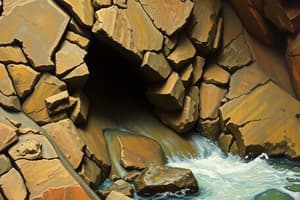Podcast
Questions and Answers
Molten rock is known as _____
Molten rock is known as _____
magma
A change in form is called _____
A change in form is called _____
metamorphic
The hardest mineral is _____
The hardest mineral is _____
diamond
An igneous rock is known as _____
An igneous rock is known as _____
Small rock particles are known as _____
Small rock particles are known as _____
A metamorphic rock is _____
A metamorphic rock is _____
The building block of rocks is _____
The building block of rocks is _____
Resistance to scratching is referred to as _____
Resistance to scratching is referred to as _____
The transfer of rock particles is known as _____
The transfer of rock particles is known as _____
The breaking down of rocks is termed _____
The breaking down of rocks is termed _____
Which of the following are examples of rock-forming minerals? (Select all that apply)
Which of the following are examples of rock-forming minerals? (Select all that apply)
In what ways are sugar and salt similar?
In what ways are sugar and salt similar?
In what ways are sugar and salt different?
In what ways are sugar and salt different?
Are sugar and salt both minerals? Explain your answer.
Are sugar and salt both minerals? Explain your answer.
How do you define a mineral?
How do you define a mineral?
What is a rock?
What is a rock?
What are the types of rocks?
What are the types of rocks?
How are the different types of rocks formed?
How are the different types of rocks formed?
How are rock fragments or particles transferred to different locations?
How are rock fragments or particles transferred to different locations?
Flashcards are hidden until you start studying
Study Notes
Introductory Concepts
- Rocks constitute the solid structure of Earth, forming the planet's surface.
- Minerals are the fundamental raw materials that compose rocks and are vital natural resources.
- Rock formations contribute to natural beauty and are shaped by exogenic processes influenced by wind, water, and ice.
- Weathering breaks down rocks into smaller particles, which are then transported through erosion.
Learning Competencies
- Ability to identify common rock-forming minerals through physical and chemical properties.
- Skills in classifying rocks into three main types: igneous, sedimentary, and metamorphic.
- Understanding the processes of erosion and how weathering products are deposited elsewhere.
Activities Overview
- Rearranging jumbled letters to form terms related to rocks and minerals.
- Identifying rock-forming minerals through images and discussing their familiar properties.
- Comparing sugar and salt to determine similarities, differences, and their classification as minerals.
Rock Cycle Exploration
- Minerals, including salt, contribute to the formation of rocks which undergo various changes over time.
- Completion of diagrams to illustrate how igneous, sedimentary, and metamorphic rocks are formed through cyclical processes.
Classification and Definitions
- Rocks are solid aggregates composed of one or more minerals.
- Minerals are inorganic substances characterized by a specific chemical composition and crystal structure.
- Types of rocks:
- Igneous: Formed from cooled molten rock.
- Sedimentary: Created from the compaction and cementation of rock particles.
- Metamorphic: Resulting from the transformation of existing rocks due to heat and pressure.
Characteristics of Minerals
- Formed through the organization of molecules in a repeating pattern, leading to solid crystals.
- The properties of minerals are determined by the types and quantities of atoms within their structure.
Transportation of Rock Fragments
- Rock fragments are moved from one location to another via natural forces such as water flow, wind action, and glacial movement.
Studying That Suits You
Use AI to generate personalized quizzes and flashcards to suit your learning preferences.




